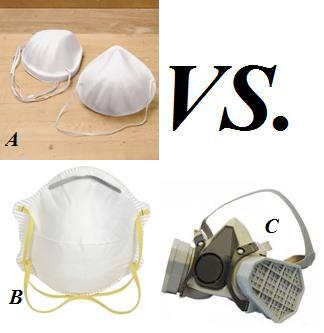 In last week’s Safety Sunday article, we covered how to properly care and maintain a respirator, but did not get into how to choose the necessary filter, or when a dust mask might be sufficient. We plan to rectify part of that in this article, but first we are going to have a small pop quiz – based on the picture above, can you identify which one(s) are a dust mask and which one(s) are a respirator?
In last week’s Safety Sunday article, we covered how to properly care and maintain a respirator, but did not get into how to choose the necessary filter, or when a dust mask might be sufficient. We plan to rectify part of that in this article, but first we are going to have a small pop quiz – based on the picture above, can you identify which one(s) are a dust mask and which one(s) are a respirator?
The Answer:
Welcome to the good ole US of A, where any filter or device tested by NIOSH is automatically classified as a respirator – so that N95 “Dust Mask” in picture B is actually a respirator. If you are surprised about that, do not feel too bad – based off the many displays I see, websites that sell them, etc… I was actually surprised that this is the case & I have a feeling many other contractors will be also. Unfortunately for many contractors, this means that they be in for a nasty surprise if OSHA stops by.
A) Nuisance Dust Mask:
These masks are not tested or approved by the government, and quite honestly not my first choice to use. However if worn properly, it will beat a bandana or using allergy pills, when mowing grass, sanding, working in a dusty area, and other weekend warrior projects. That being said, you should probably consider moving up to a Disposable Respirator, especially if you are working on a house built before 78, Bondo, or fiberglass. Cost: anywhere from .10¢ to a $1
B) Disposable Respirator:
Most of these are labeled N95, which means that if worn properly it has been tested to block 95% of non-oil based particulates. This filter will generally suffice for most tasks you will be performing around the house, but it would be wise to check the labels on any pesticides, or any other chemicals you might be using. If you are planning on doing any welding, working with oil-based products, looking for a respirator with better filtering – you are in luck as there are quite a few options available in disposable format (P95 – blocks the same as the N95 but also 95% oil-based particulates &, while a P100 is tested to 99.77%). Cost: anywhere from .59¢ to $10
C) Half-Face Respirator
A Half-Face Respirator is generally overkill for most homeowners doing the occasional odd job around the house. However, if you are doing a lot of painting, remodeling, auto bodywork, etc… it would probably be a good investment. Cost: anywhere from $2 to $25 per cartridge (average replacement set for “Residential sets” around $10 to $15)
Choosing the right cartridge or disposable respirator:
- Refer to the directions & warnings printed on the containers, or refer to the MSDS sheets that manufacturers are required to make available
- Refer to the respirator manufacturers tables for which cartridge will fit your mask & work best where; Cartridges can be made to handle more than 1 type of issue; for instance if you are cleaning up after a fire, you might want a N95 with a charcoal filter to help eliminate the smoke smell & protect you from the particles
Additional Info & Websites:
Tool Box Talk: OSHA’s General Respiratory Protection Guidance for Employers and Workers
OSHA Respirator Standards 1910.134 (Do you have your respirator program in place, yearly medical examinations setup, etc… if you use the dispossable respirators – you need to understand this)
Safety Sunday: Respirator Care & Maintenance
